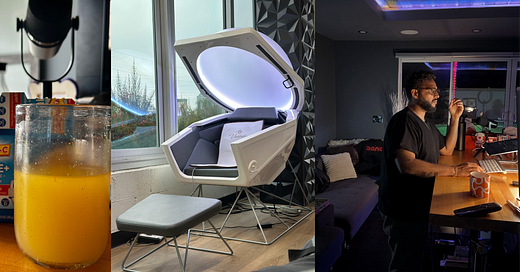Dear Community,
It’s midnight PST. Shruti and I just landed from a business trip a few hours ago, and this newsletter’s due in eight.
But truthfully, I couldn’t wait to share this one. There’s so much I’ve been sitting with…on both the personal and professional front and when I thought about what to spotlight across the 3Cs this week, a theme surfaced:
The Invisible Edition.
You’ll see why.
Also, a quick note, when I write these, I usually fall into a flow state, looping the same track on repeat. Shruti had the brilliant idea to share that with you, so you can read it in the same rhythm I wrote it in.
Hit play. Let’s begin.
May was a month of motion, filled with unexpected detours, deep reflections, and creative clarity.
I had the honor of attending the 2025 Welcoming Interactive in Detroit as a board member of Welcoming America, an organization I’m deeply proud to support. This wasn’t just a conference, it was a convergence of over 850 educators, city officials, nonprofit leaders, and community architects all working toward a shared future rooted in belonging and humanity.
As someone who comes from a refugee family, this work is more than professional, it’s personal. I know what it means to start over in an unfamiliar place, and to experience firsthand the transformative power of being welcomed.
The summit was a reminder: welcoming, it’s strategy. It’s how we build resilient communities and shape a better future for the next generation
Shortly after, our team jumped headfirst into a bold new creative endeavour: Project Code #D71B32 and in doing so, ran our first real-time case study on using Discord as our new cultural lab. We’ve moved beyond the polished walls of Slack and started migrating our community where our Gen Z network actually wants to connect…low-pressure, high-vibe, invite-only spaces that feel less like performance and more like presence.
As a gesture to commemorate this shift, we’re also experimenting with digital collectibles. We’re working on launching our first limited-edition DANG NFTs. More on that soon.
Then, life intervened: I caught COVID. It forced me to pause, reflect, and get deeply focused again. In these moments, I always turn to books. They’re not just inspiration, they’re fuel for recalibration. I shared a few that have shaped my perspective in this recent post.
And lately, I’ve been feeling it firsthand, this quiet shift in how Gen Z connects, expresses, and belongs.
The loudest platforms are starting to feel empty. The real action? It’s happening in ambient corners, in invisible apps, in digital wallets—not public feeds.
Where identity is softer. Ownership is the new signal. And connection feels less performative, more real.
That’s what this edition is about…..the rise of invisible platforms and digital identity as culture.
Not just as trends but as tools we’re using to build what’s next.
CULTURESCOPE: WHY INVISIBLE PLATFORMS SIGNAL DEEPER PRESENCE
The next social revolution? You won’t even see it coming.
Apps like Airbuds, Shelf, and Nospace are rejecting the pressure of performative posting. They let users passively share what they’re listening to, reading, or loving with no feeds, no filters, no pressure to perform.
Even collectibles are shifting. Digital badges, music drops, and low-key NFT assets are becoming ambient flexes. Less about broadcasting. More about belonging.
Why This Matters: Gen Z isn’t chasing attention. They’re curating presence. Identity is becoming quieter and more intentional.
What Brands Can Learn:
Don’t compete for attention. Build for background presence with actions.
Use ambient signals: badges, moods, motion…to express community.
Personalization doesn’t need polish. It needs precision.
Build platforms that whisper value, not shout for engagement.
COMMUNITYVIBES: WHY COLLECTIBLES ARE THE NEW MEMBERSHIP CARDS
This generation was raised on gaming. Even if they don’t identify as “gamers,” they grew up inside interactive ecosystems…leveling up, unlocking rewards, customizing avatars. That mindset rewired how they experience the world: fast, personalized, participatory.
Social media only amplified it.
Likes became points. Comments became quests. TikToks became missions. The gamer mindset isn’t niche, it’s native.
That’s why I constantly tap into the gaming world to track what’s next. I talk to players in our Next-Gen community to understand what’s shifting and what it reveals about Gen Z behavior at large.
One name that keeps coming up: Kai Cenat.
With Streamer University, Kai’s not just gaming, he’s world-building. He’s turning livestreams into full-blown cultural campuses, where fans aren’t passive viewers, they’re part of the curriculum. There are roles, rituals, consequences. You don’t just watch, you enroll.
Because one thing is clear:
This generation want to own part of the story.
That instinct is baked into their code. And it’s why I always tell my partners…don’t miss the moment to co-create.
We’re seeing that truth show up in the evolution of digital collectibles.
From Fortnite skins to loyalty NFTs, these aren’t just digital assets, they’re community credentials. Membership cards to experiences, early drops, and identity signaling.
Why This Matters:
In Gen Z’s world, community isn’t built through likes or follows. It’s built through co-ownership.
What Brands Can Learn:
Treat collectibles as loyalty infrastructure, not fan service
Drop unlockable assets tied to your cultural ecosystem
Create digital identity pieces your community can flex
Don’t just design assets, build long-term value behind them
COMMERCELENS: WHERE COMMERCE GOES QUIET BUT STICKS LOUD

 Tiktok failed to load.
Tiktok failed to load.Enable 3rd party cookies or use another browser
The smartest brands in 2025 aren’t building louder campaigns. They’re building quieter systems.
Spotify uses behavior-based AI to tie merch directly to mood. Apps like Zeebu are shifting loyalty from inboxes to owned, tokenized keys.
This is the new wave of commerce: private, ambient, and asset-driven.
Why This Matters: Gen Z wants less friction and more feeling. If loyalty isn’t experiential, it’s expendable.
What Brands Can Learn:
Use owned assets to create seamless commerce moments.
Think beyond rewards. Build rituals.
Let behavior, not browsing, drive drops.
Quiet loyalty is sticky loyalty.
INTO THE NEXT-GEN MULTIVERSE
I asked Johnny, a 19-year-old creator, about influencers vs. celebrities. His response?
“Influencers still feel like us. They’re relatable. That’s why they impact how we buy.”
The conversation turned into something deeper.
Johnny doesn’t just follow for the aesthetic. He follows for alignment. For access. For authenticity. And he’s not alone.
Then there’s Trey, 20, who talked to me about collectibles and nostalgia. For him, it’s about emotional context: “We want things that remind us of a time we felt safe and we want to carry those signals forward in new ways.”
What they’re both describing is the same shift I’ve been seeing all month: identity is becoming more ambient. More feeling. More personal.
NEXT-GEN CENTRICITY™ NUGGET
WHY INVISIBLE IS THE NEW INFLUENTIAL
Gen Z isn’t logging off. They’re logging in…differently.
They’re choosing invisible platforms, ambient flexes, digital badges, and low-pressure signals that say: I belong here.
This is the future of influence and it’s not loud. It’s layered.
What Brands Can Do:
Build ambient UX experiences that signal presence, and then push content.
Turn loyalty programs into collectible ecosystems.
Let your most valuable interactions happen in private, not public.
Create quiet rituals that turn into loud affinity.
Let’s build something that actually feels made for them.
Until next time, Karan.













Hey Karan - absolutely loving all your content!!! Hopefully we get to cross paths again one day xxx